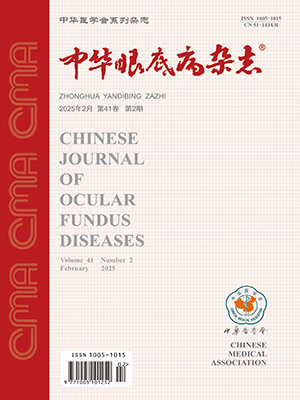| 1. |
Ghose S, Sachdev MS, Kumar H. Bilateral nanophthalmos, pigmentary retinal dystrophy, and angle closure glaucoma-a new syndrome?[J]. Br J Ophthalmol, 1985, 69(8): 624-628. DOI: 10.1136/bjo.69.8.624.
|
| 2. |
Altintaş AK, Acar MA, Yalvaç IS, et al. Autosomal recessive nanophthalmos[J]. Acta Ophthalmol Scand, 1997, 75(3): 325-328. DOI: 10.1111/j.1600-0420.1997.tb00788.x.
|
| 3. |
Källén B, Tornqvist K. The epidemiology of anophthalmia and microphthalmia in Sweden[J]. Eur J Epidemiol, 2005, 20(4): 345-350. DOI: 10.1007/s10654-004-6880-1.
|
| 4. |
Hornby SJ, Xiao Y, Gilbert CE, et al. Causes of childhood blindness in the People's Republic of China: results from 1131 blind school students in 18 provinces[J]. Br J Ophthalmol, 1999, 83(8): 929-932. DOI: 10.1136/bjo.83.8.929.
|
| 5. |
Prasov L, Guan B, Ullah E, et al. Novel TMEM98, MFRP, PRSS56 variants in a large United States high hyperopia and nanophthalmos cohort[J/OL]. Sci Rep, 2020, 10(1): 19986[2020-11-17]. https://pubmed.ncbi.nlm.nih.gov/33203948/. DOI: 10.1038/s41598-020-76725-8.
|
| 6. |
Won J, Smith RS, Peachey NS, et al. Membrane frizzled-related protein is necessary for the normal development and maintenance of photoreceptor outer segments[J]. Vis Neurosci, 2008, 25(4): 563-574. DOI: 10.1017/S0952523808080723.
|
| 7. |
Carricondo PC, Andrade T, Prasov L, et al. Nanophthalmos: a review of the clinical spectrum and genetics[J/OL]. J Ophthalmol, 2018, 2018: 2735465[20180-05-09]. https://pubmed.ncbi.nlm.nih.gov/29862063/. DOI: 10.1155/2018/2735465.
|
| 8. |
Richards S, Aziz N, Bale S, et al. Standards and guidelines for the interpretation of sequence variants: a joint consensus recommendation of the American College of Medical Genetics and Genomics and the Association for Molecular Pathology[J]. Genet Med, 2015, 17(5): 405-424. DOI: 10.1038/gim.2015.30.
|
| 9. |
Katoh M. Molecular cloning and characterization of MFRP, a novel gene encoding a membrane-type frizzled-related protein[J]. Biochem Biophys Res Commun, 2001, 282(1): 116-123. DOI: 10.1006/bbrc.2001.4551.
|
| 10. |
Rong SS, Tang FY, Chu WK, et al. Genetic associations of primary angle-closure disease: a systematic review and meta-analysis[J]. Ophthalmology, 2016, 123(6): 1211-1221. DOI: 10.1016/j.ophtha.2015.12.027.
|
| 11. |
Nowilaty SR, Khan AO, Aldahmesh MA, et al. Biometric and molecular characterization of clinically diagnosed posterior microphthalmos[J]. Am J Ophthalmol, 2013, 155(2): 361-372. DOI: 10.1016/j.ajo.2012.08.016.
|
| 12. |
Aldahmesh MA, Nowilaty SR, Alzahrani F, et al. Posterior microphthalmos as a genetically heterogeneous condition that can be allelic to nanophthalmos[J]. Arch Ophthalmol, 2011, 129(6): 805-807. DOI: 10.1001/archophthalmol.2011.129.
|
| 13. |
Khan AO. Posterior microphthalmos versus nanophthalmos[J/OL]. Ophthalmic Genet, 2008, 29(4): 189[2009-07-08]. https://pubmed.ncbi.nlm.nih.gov/19005993/. DOI: 10.1080/13816810802258862.
|
| 14. |
Kameya S, Hawes NL, Chang B, et al. MFRP, a gene encoding a frizzled related protein, is mutated in the mouse retinal degeneration 6[J]. Hum Mol Genet, 2002, 11(16): 1879-1886. DOI: 10.1093/hmg/11.16.1879.
|
| 15. |
Mukhopadhyay R, Sergouniotis PI, Mackay DS, et al. A detailed phenotypic assessment of individuals affected by MFRP-related oculopathy[J]. Mol Vis, 2010, 16: 540-548.
|
| 16. |
Wasmann RA, Wassink-Ruiter JS, Sundin OH, et al. Novel membrane frizzled-related protein gene mutation as cause of posterior microphthalmia resulting in high hyperopia with macular folds[J]. Acta Ophthalmol, 2014, 92(3): 276-281. DOI: 10.1111/aos.12105.
|
| 17. |
Matsushita I, Kondo H, Tawara A. Novel compound heterozygous mutations in the MFRP gene in a Japanese patient with posterior microphthalmos[J]. Jpn J Ophthalmol, 2012, 56(4): 396-400. DOI: 10.1007/s10384-012-0145-4.
|
| 18. |
Lang E, Koller S, Atac D, et al. Genotype-phenotype spectrum in isolated and syndromic nanophthalmos[J]. Acta Ophthalmol, 2021, 99(4): e594-e607. DOI: 10.1111/aos.14615.
|
| 19. |
Sundin OH, Leppert GS, Silva ED, et al. Extreme hyperopia is the result of null mutations in MFRP, which encodes a Frizzled-related protein[J]. Proc Natl Acad Sci USA, 2005, 102(27): 9553-9558. DOI: 10.1073/pnas.0501451102.
|
| 20. |
Zenteno JC, Buentello-Volante B, Quiroz-González MA, et al. Compound heterozygosity for a novel and a recurrent MFRP gene mutation in a family with the nanophthalmos-retinitis pigmentosa complex[J]. Mol Vis, 2009, 15: 1794-1798.
|
| 21. |
Almoallem B, Arno G, De Zaeytijd J, et al. The majority of autosomal recessive nanophthalmos and posterior microphthalmia can be attributed to biallelic sequence and structural variants in MFRP and PRSS56[J/OL]. Sci Rep, 2020, 10(1): 1289[2020-01-28]. https://pubmed.ncbi.nlm.nih.gov/31992737/. DOI: 10.1038/s41598-019-57338-2.
|
| 22. |
Xu Y, Guan L, Xiao X, et al. Identification of MFRP mutations in Chinese families with high hyperopia[J]. Optom Vis Sci, 2016, 93(1): 19-26. DOI: 10.1097/OPX.0000000000000751.
|
| 23. |
Wang J, Zhang VW, Feng Y, et al. Dependable and efficient clinical utility of target capture-based deep sequencing in molecular diagnosis of retinitis pigmentosa[J]. Invest Ophthalmol Vis Sci, 2014, 55(10): 6213-6223. DOI: 10.1167/iovs.14-14936.
|
| 24. |
Dinculescu A, Estreicher J, Zenteno JC, et al. Gene therapy for retinitis pigmentosa caused by MFRP mutations: human phenotype and preliminary proof of concept[J]. Hum Gene Ther, 2012, 23(4): 367-376. DOI: 10.1089/hum.2011.169.
|
| 25. |
Godinho G, Madeira C, Grangeia A, et al. A novel MFRP gene variant in a family with posterior microphthalmos, retinitis pigmentosa, foveoschisis, and foveal hypoplasia[J]. Ophthalmic Genet, 2020, 41(5): 474-479. DOI: 10.1080/13816810.2020.1795888.
|
| 26. |
Ayala-Ramirez R, Graue-Wiechers F, Robredo V, et al. A new autosomal recessive syndrome consisting of posterior microphthalmos, retinitis pigmentosa, foveoschisis, and optic disc drusen is caused by a MFRP gene mutation[J]. Mol Vis, 2006, 12: 1483-1489.
|




